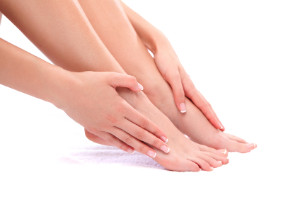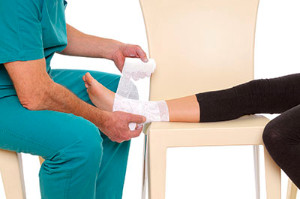Blogs
What is Athlete’s Foot?
 Athlete’s foot, also known as tinea pedis, is a common fungal infection. Symptoms of the condition include itchiness, redness, flaking, and scaly skin. Although a variety of different fungi may cause athlete’s foot, they all thrive on moisture. The condition spreads through contact with the fungi itself or contact with infected skin. Areas such as damp locker rooms, bathroom floors, showers, and swimming pools are all prime breeding areas for the fungi. If you want to prevent yourself from getting athlete’s foot, you should be sure to wash all socks, towels, bath mats, and sheets that may have come in contact with the infection. Another tip is to always make sure you wear shower shoes while walking in moist areas. Keeping your feet warm and dry will also help prevent athlete’s foot.
Athlete’s foot, also known as tinea pedis, is a common fungal infection. Symptoms of the condition include itchiness, redness, flaking, and scaly skin. Although a variety of different fungi may cause athlete’s foot, they all thrive on moisture. The condition spreads through contact with the fungi itself or contact with infected skin. Areas such as damp locker rooms, bathroom floors, showers, and swimming pools are all prime breeding areas for the fungi. If you want to prevent yourself from getting athlete’s foot, you should be sure to wash all socks, towels, bath mats, and sheets that may have come in contact with the infection. Another tip is to always make sure you wear shower shoes while walking in moist areas. Keeping your feet warm and dry will also help prevent athlete’s foot.
Athlete’s foot is an inconvenient condition that can be easily reduced with the proper treatment. If you have any concerns about your feet and ankles, contact Dr. Dean D. Hinners from Illinois. Our doctor will treat your foot and ankle needs.
Athlete’s Foot: The Sole Story
Athlete's foot, also known as tinea pedis, can be an extremely contagious foot infection. It is commonly contracted in public changing areas and bathrooms, dormitory style living quarters, around locker rooms and public swimming pools, or anywhere your feet often come into contact with other people.
Solutions to Combat Athlete’s Foot
- Hydrate your feet by using lotion
- Exfoliate
- Buff off nails
- Use of anti-fungal products
- Examine your feet and visit your doctor if any suspicious blisters or cuts develop
Athlete’s foot can cause many irritating symptoms such as dry and flaking skin, itching, and redness. Some more severe symptoms can include bleeding and cracked skin, intense itching and burning, and even pain when walking. In the worst cases, Athlete’s foot can cause blistering as well. Speak to your podiatrist for a better understanding of the different causes of Athlete’s foot, as well as help in determining which treatment options are best for you.
If you have any questions please feel free to contact one of our offices located in Metropolis and Eldorado, IL . We offer the newest diagnostic and treatment technologies for all your foot and ankle needs.
Read more about Athlete's FootChoose the Right Running Shoe For You
One of the bes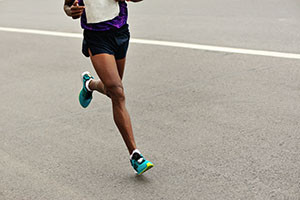 t ways to avoid running injuries is to make sure you are wearing properly fitting shoes. There are three types of running shoes: stability/neutral, cushion, and motion control. Prior to starting your running program, it is crucial that you buy the right shoe type for the activity you are about to partake in. Shoes also have different components that serve different purposes. The part that is responsible for providing support is called the midsole. The midsole acts as a shock absorber, which protects your body from the dangers of repeated loading from running. The stiffer the midsole, the more control the shoe gives your foot. It is important that you try on the shoe you want before purchasing to ensure that it is great fit for you.
t ways to avoid running injuries is to make sure you are wearing properly fitting shoes. There are three types of running shoes: stability/neutral, cushion, and motion control. Prior to starting your running program, it is crucial that you buy the right shoe type for the activity you are about to partake in. Shoes also have different components that serve different purposes. The part that is responsible for providing support is called the midsole. The midsole acts as a shock absorber, which protects your body from the dangers of repeated loading from running. The stiffer the midsole, the more control the shoe gives your foot. It is important that you try on the shoe you want before purchasing to ensure that it is great fit for you.
If you are a runner, wearing the right running shoe is essential. For more information, contact Dr. Dean D. Hinners from Illinois. Our doctor can provide the care you need to keep you pain-free and on your feet.
Choosing the Right Running Shoe for Your Foot Type
To increase performance and avoid the risk of injury, it is important to choose the right running shoe based on your foot type. The general design of running shoes revolves around pronation, which is how the ankle rolls from outside to inside when the foot strikes the ground.
- Neutral runners are able to choose from a wide variety of shoes, including minimalist shoes or even going barefoot.
- Runners who overpronate, or experience an over-abundance of ankle rolling, should choose shoes that provide extra motion control and stability.
- Runners who underpronate, or supinate, have feet that have high arches and lack flexibility, preventing shock absorption. They require shoes with more flexibility and cushion.
If you have any questions please feel free to contact one of our offices located in Metropolis and Eldorado, IL . We offer the newest diagnostic and treatment technologies for all your foot and ankle needs.
Read more about Choosing the Right Running Shoe for Your Foot TypeFinding the Perfect Shoe for You
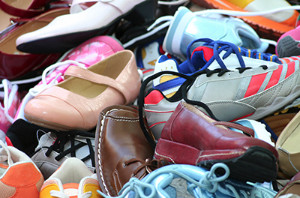 It is crucial for people of all ages to have properly fitting shoes. You should always try on shoes while in the shoestore in order to make sure you are getting the right fit. A new pair of shoes should never pinch your feet, and there should be at least one finger length of space at the top of the shoe. Additionally, your heel should have a firm positioning inside of the shoe. It is advised that the shoe buyer takes a walk around in the store for several minutes before making a purchase, in order to know if the shoes fit properly.
It is crucial for people of all ages to have properly fitting shoes. You should always try on shoes while in the shoestore in order to make sure you are getting the right fit. A new pair of shoes should never pinch your feet, and there should be at least one finger length of space at the top of the shoe. Additionally, your heel should have a firm positioning inside of the shoe. It is advised that the shoe buyer takes a walk around in the store for several minutes before making a purchase, in order to know if the shoes fit properly.
Finding a properly-fitting shoe is important in reducing injuries and preventing foot problems. For more information about treatment, contact Dr. Dean D. Hinners from Illinois. Our doctor will treat your foot and ankle needs.
Proper Shoe Fitting
A common concern when it comes to foot health, having properly fitted shoes can help prevent injuries to the foot. Out feet affect our posture and gait, which in turn affects the biomechanics and overall bodily structure. With 33 joints, 26 bones, and over 100 ligaments, the potential for serious injury is much greater than one realizes. Although the feet cease growth in adulthood, they still change shape as they mature. Here are some factors to consider when it comes to investing in proper fitting shoes:
- Be sure the shoes fit correctly right away
- Ensure the ball of your foot fits comfortably in the widest portion of the shoes
- Even though they may look fashionable, improper fitting shoes can either create adverse conditions or exacerbate existing ones you may already have
- Walk along a carpeted surface to ensure the shoes comfortably fit during normal activity
Keeping in mind how shoes fit the biomechanics of your body, properly-fitting shoes are vitally important. Fortunately, it is not difficult to acquire footwear that fits correctly. Be sure to wear shoes that support the overall structure of your body. Do your feet a favor and invest in several pairs of well-fitted shoes today.
If you have any questions please feel free to contact one of our offices located in Metropolis and Eldorado, IL . We offer the newest diagnostic and treatment technologies for all your foot and ankle needs.
Read more about Proper Shoe FittingHandling Heel Spurs
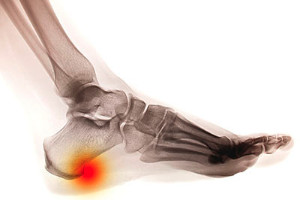 Heel spurs are potentially painful abnormalities that result from calcium deposits forming a protrusion on the underside of the heel bone. They are most common among athletes and people who do a lot of running. They are typically caused by stretching of the plantar fascia or tearing of the heel bone membrane. Depending on the severity of the heel spur, surgery may need to be performed in order to remove the calcium deposits. If you have pain in your heel, seeing a podiatrist is highly recommended. In the meantime, there are some remedies that may be able to help with the pain. These include: soaking your feet in an epsom salt bath, an apple cider vinegar bath, or applying an ice pack to the affected area.
Heel spurs are potentially painful abnormalities that result from calcium deposits forming a protrusion on the underside of the heel bone. They are most common among athletes and people who do a lot of running. They are typically caused by stretching of the plantar fascia or tearing of the heel bone membrane. Depending on the severity of the heel spur, surgery may need to be performed in order to remove the calcium deposits. If you have pain in your heel, seeing a podiatrist is highly recommended. In the meantime, there are some remedies that may be able to help with the pain. These include: soaking your feet in an epsom salt bath, an apple cider vinegar bath, or applying an ice pack to the affected area.
Heel spurs can be incredibly painful and sometimes may make you unable to participate in physical activities. To get medical care for your heel spurs, contact Dr. Dean D. Hinners from Illinois. Our doctor will do everything possible to treat your condition.
Heels Spurs
Heel spurs are formed by calcium deposits on the back of the foot where the heel is. This can also be caused by small fragments of bone breaking off one section of the foot, attaching onto the back of the foot. Heel spurs can also be bone growth on the back of the foot and may grow in the direction of the arch of the foot.
Older individuals usually suffer from heel spurs and pain sometimes intensifies with age. One of the main condition's spurs are related to is plantar fasciitis.
Pain
The pain associated with spurs is often because of weight placed on the feet. When someone is walking, their entire weight is concentrated on the feet. Bone spurs then have the tendency to affect other bones and tissues around the foot. As the pain continues, the feet will become tender and sensitive over time.
Treatments
There are many ways to treat heel spurs. If one is suffering from heel spurs in conjunction with pain, there are several methods for healing. Medication, surgery, and herbal care are some options.
If you have any questions feel free to contact one of our offices located in Metropolis and Eldorado, IL . We offer the latest in diagnostic and treatment technology to meet your needs.
Read more about Heel SpursPerils of Ingrown Toenails
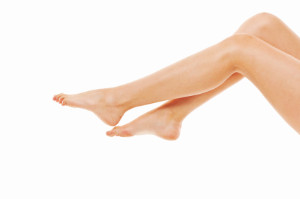 If you have ever experienced an ingrown toenail, you know how painful and how much of a hindrance it can be. It occurs when part of the toenail grows into the tissue of the toe. This can turn into a serious condition, as swelling and infection may result. Medically known as onychocryptosis, this disorder is typically caused by over clipping of toenails or wearing shoes that do not fit properly. With nearly 3 million cases of patients with ingrown toenails, it is important to contact your podiatrist to learn about proper treatment.
If you have ever experienced an ingrown toenail, you know how painful and how much of a hindrance it can be. It occurs when part of the toenail grows into the tissue of the toe. This can turn into a serious condition, as swelling and infection may result. Medically known as onychocryptosis, this disorder is typically caused by over clipping of toenails or wearing shoes that do not fit properly. With nearly 3 million cases of patients with ingrown toenails, it is important to contact your podiatrist to learn about proper treatment.
Ingrown toenails can become painful if they are not treated properly. For more information about ingrown toenails, contact Dr. Dean D. Hinners of Illinois. Our doctor can provide the care you need to keep you pain-free and on your feet.
Ingrown Toenails
Ingrown toenails occur when a toenail grows sideways into the bed of the nail, causing pain, swelling, and possibly infection.
Causes
- Bacterial infections
- Improper nail cutting such as cutting it too short or not straight across
- Trauma to the toe, such as stubbing, which causes the nail to grow back irregularly
- Ill-fitting shoes that bunch the toes too close together
- Genetic predisposition
Prevention
Because ingrown toenails are not something found outside of shoe-wearing cultures, going barefoot as often as possible will decrease the likeliness of developing ingrown toenails. Wearing proper fitting shoes and using proper cutting techniques will also help decrease your risk of developing ingrown toenails.
Treatment
Ingrown toenails are a very treatable foot condition. In minor cases, soaking the affected area in salt or antibacterial soaps will not only help with the ingrown nail itself, but also help prevent any infections from occurring. In more severe cases, surgery is an option. In either case, speaking to your podiatrist about this condition will help you get a better understanding of specific treatment options that are right for you.
If you have any questions please feel free to contact one of our offices located in Metropolis and Eldorado, IL . We offer the newest diagnostic and treatment technologies for all your foot and ankle needs.
Read more about Ingrown Toenail CareManaging Sweaty Feet
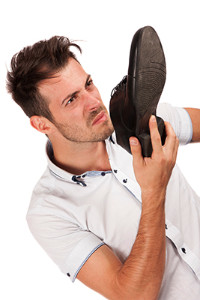 When the feet are kept wrapped up in thick socks and heavy winter boots, sweat is no surprise. Sweat from the feet is a natural occurrence, however there are a number of tips you can rely on to ease sweaty and potentially smelly feet: Take off your shoes as soon as you get home to air out the feet, rotate between shoes and avoid wearing the same pair consistently everyday, and wash the feet thoroughly when bathing, especially after exercise. If you are experiencing sweaty feet all year round, you may have a disorder called hyperhidrosis. Speak with your doctor in order to discuss treatment options for this condition.
When the feet are kept wrapped up in thick socks and heavy winter boots, sweat is no surprise. Sweat from the feet is a natural occurrence, however there are a number of tips you can rely on to ease sweaty and potentially smelly feet: Take off your shoes as soon as you get home to air out the feet, rotate between shoes and avoid wearing the same pair consistently everyday, and wash the feet thoroughly when bathing, especially after exercise. If you are experiencing sweaty feet all year round, you may have a disorder called hyperhidrosis. Speak with your doctor in order to discuss treatment options for this condition.
If you are suffering from hyperhidrosis contact Dr. Dean D. Hinners of Illinois. Our doctor can provide the care you need to attend to all of your foot and ankle needs.
Hyperhidrosis of the Feet
Hyperhidrosis is a rare disorder that can cause people to have excessive sweating of their feet. This can usually occur all on its own without rigorous activity involved. People who suffer from hyperhidrosis may also experience sweaty palms.
Although it is said that sweating is a healthy process meant to cool down the body temperature and to maintain a proper internal temperature, hyperhidrosis may prove to be a huge hindrance on a person’s everyday life.
Plantar hyperhidrosis is considered to be the main form of hyperhidrosis. Secondary hyperhidrosis can refer to sweating that occurs in areas other than the feet or hands and armpits. Often this may be a sign of it being related to another medical condition such as menopause, hyperthyroidism and even Parkinson’s disease.
In order to alleviate this condition, it is important to see your doctor so that they may prescribe the necessary medications so that you can begin to live a normal life again. If this is left untreated, it is said that it will persist throughout an individual’s life.
A last resort approach would be surgery, but it is best to speak with your doctor to find out what may be the best treatment for you.
If you have any questions please feel free to contact one of our offices located in Metropolis and Eldorado, IL . We offer the newest diagnostic and treatment technologies for all your foot and ankle needs.
Read more about Hyperhidrosis of the Feet3D-Printing is the Future of Running shoes
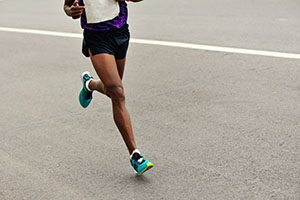 Running shoe companies are looking to 3D-printing to provide customers with the comfort and customization many runners require in running shoes. A new 3D-printing process, “selective laser sintering,” creates components of a shoe one layer at a time and allows companies to engineer the structure of a shoe, from outsole to midsole. Companies such as Nike, New Balance, and Adidas have used 3D-printing in recent releases. The new process will allow athletic companies to create one-of-a-kind models from the bottom up and to hone in quickly on custom fits for their clients and their running shoe needs.
Running shoe companies are looking to 3D-printing to provide customers with the comfort and customization many runners require in running shoes. A new 3D-printing process, “selective laser sintering,” creates components of a shoe one layer at a time and allows companies to engineer the structure of a shoe, from outsole to midsole. Companies such as Nike, New Balance, and Adidas have used 3D-printing in recent releases. The new process will allow athletic companies to create one-of-a-kind models from the bottom up and to hone in quickly on custom fits for their clients and their running shoe needs.
If you are a runner, wearing the right running shoe is essential. For more information, contact Dr. Dean D. Hinners from Illinois. Our doctor can provide the care you need to keep you pain-free and on your feet.
Choosing the Right Running Shoe for Your Foot Type
To increase performance and avoid the risk of injury, it is important to choose the right running shoe based on your foot type. The general design of running shoes revolves around pronation, which is how the ankle rolls from outside to inside when the foot strikes the ground.
- Neutral runners are able to choose from a wide variety of shoes, including minimalist shoes or even going barefoot.
- Runners who overpronate, or experience an over-abundance of ankle rolling, should choose shoes that provide extra motion control and stability.
- Runners who underpronate, or supinate, have feet that have high arches and lack flexibility, preventing shock absorption. They require shoes with more flexibility and cushion.
If you have any questions please feel free to contact one of our offices located in Metropolis and Eldorado, IL . We offer the newest diagnostic and treatment technologies for all your foot and ankle needs.
Read more about Choosing the Right Running Shoe for Your Foot TypeCauses of Heel Pain
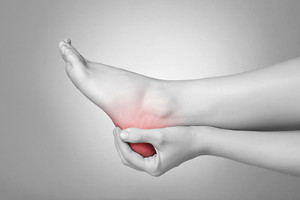 Heel pain is a condition that plagues many people, and chronic cases can be especially difficult to endure. For many common cases of chronic heel pain, plantar fasciitis is the underlying culprit; plantar fasciitis affects all types of people, though most commonly active men between the ages of 40 and 70. Plantar fasciitis pain manifests in various ways. For some people, it can be described as dull; in other cases, people feel it as a sharp pain, a burning sensation, or an ache that extends outward from the heel. There are various factors that can contribute to plantar fasciitis. To determine the cause of your heel pain and the best way to treat it, consult with your podiatrist.
Heel pain is a condition that plagues many people, and chronic cases can be especially difficult to endure. For many common cases of chronic heel pain, plantar fasciitis is the underlying culprit; plantar fasciitis affects all types of people, though most commonly active men between the ages of 40 and 70. Plantar fasciitis pain manifests in various ways. For some people, it can be described as dull; in other cases, people feel it as a sharp pain, a burning sensation, or an ache that extends outward from the heel. There are various factors that can contribute to plantar fasciitis. To determine the cause of your heel pain and the best way to treat it, consult with your podiatrist.
Many people suffer from bouts of heel pain. For more information, contact Dr. Dean D. Hinners of Illinois. Our doctor can provide the care you need to keep you pain-free and on your feet.
Causes of Heel Pain
Heel pain is often associated with plantar fasciitis. The plantar fascia is a band of tissues that extends along the bottom of the foot. A rip or tear in this ligament can cause inflammation of the tissue.
Achilles tendonitis is another cause of heel pain. Inflammation of the Achilles tendon will cause pain from fractures and muscle tearing. Lack of flexibility is also another symptom.
Heel spurs are another cause of pain. When the tissues of the plantar fascia undergo a great deal of stress, it can lead to ligament separation from the heel bone, causing heel spurs.
Why Might Heel Pain Occur?
- Wearing ill-fitting shoes
- Wearing non-supportive shoes
- Weight change
- Excessive running
Treatments
Heel pain should be treated as soon as possible for immediate results. Keeping your feet in a stress-free environment will help. If you suffer from Achilles tendonitis or plantar fasciitis, applying ice will reduce the swelling. Stretching before an exercise like running will help the muscles. Using all these tips will help make heel pain a condition of the past.
If you have any questions please contact one of our offices located in Metropolis and Eldorado, IL . We offer the newest diagnostic and treatment technologies for all your foot and ankle needs.
Read more about Heel PainExercises for avoiding foot pain
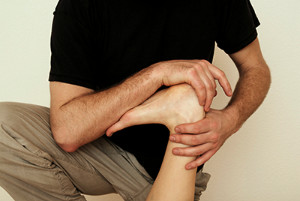 While wearing proper-fitting shoes is a well-known tip for avoiding foot pain, sometimes it may not be enough. If your shoes are comfortable and fit properly to your feet and you’re still experiencing pain, trying certain foot exercises and stretches may help. Rolling a tennis ball underneath the toes is a great way to massage the entire foot. Using your hands and fingers to stretch between the toes can also give relief. Other exercises include repeating heel and toe raises as well as toegrips, or picking up a pencil using only one foot.
While wearing proper-fitting shoes is a well-known tip for avoiding foot pain, sometimes it may not be enough. If your shoes are comfortable and fit properly to your feet and you’re still experiencing pain, trying certain foot exercises and stretches may help. Rolling a tennis ball underneath the toes is a great way to massage the entire foot. Using your hands and fingers to stretch between the toes can also give relief. Other exercises include repeating heel and toe raises as well as toegrips, or picking up a pencil using only one foot.
Exercising your feet regularly with the proper foot wear is a great way to prevent injuries and build strength. If you have any concerns about your feet, contact Dr. Dean D. Hinners from Illinois. Our doctor can provide the care you need to keep you pain-free and on your feet.
Exercise for Your Feet
Exercise for your feet can help you gain strength, mobility and flexibility in your feet. They say that strengthening your feet can be just as rewarding as strengthening another part of the body. Your feet are very important, and we often forget about them in our daily tasks. But it is because of our feet that are we able to get going and do what we need to. For those of us fortunate enough to not have any foot problems, it is an important gesture to take care of them to ensure good health in the long run.
Some foot health exercises can include ankle pumps, tip-toeing, toe rises, lifting off the floor doing reps and sets, and flexing the toes. It is best to speak with Our doctor to determine an appropriate regimen for your needs. Everyone’s needs and bodies are different, and the activities required to maintain strength in the feet vary from individual to individual.
Once you get into a routine of doing regular exercise, you may notice a difference in your feet and how strong they may become.
If you have any questions please feel free to contact one of our offices located in Metropolis and Eldorado, IL . We offer the newest diagnostic and treatment technologies for all your foot and ankle needs.
Read more about Exercise for Your FeetMaintaining Foot Health for Seniors
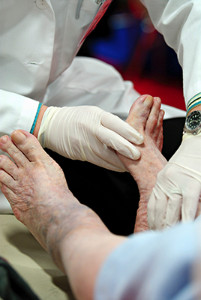 When thinking about our body and our general health, the feet are often overlooked and ignored until considerable pain or changes occur. This habit can be especially damaging for seniors, who are more likely to experience the effects of neglecting foot health at their older age. Many aches and pains are caused by ill-fitting shoes that don’t offer support. Underlying conditions, like diabetes, rheumatoid arthritis, weight gain, and prior injury, can also be a cause of pain. Outside of the podiatrist’s office, seniors can maintain foot health by ensuring that their feet are kept clean and by trimming their nails to an appropriate length.
When thinking about our body and our general health, the feet are often overlooked and ignored until considerable pain or changes occur. This habit can be especially damaging for seniors, who are more likely to experience the effects of neglecting foot health at their older age. Many aches and pains are caused by ill-fitting shoes that don’t offer support. Underlying conditions, like diabetes, rheumatoid arthritis, weight gain, and prior injury, can also be a cause of pain. Outside of the podiatrist’s office, seniors can maintain foot health by ensuring that their feet are kept clean and by trimming their nails to an appropriate length.
Proper foot care is something many older adults forget to consider. If you have any concerns about your feet and ankles, contact Dr. Dean D. Hinners from Illinois. Our doctor can provide the care you need to keep you pain-free and on your feet.
The Elderly and Their Feet
As we age we start to notice many changes in our body, but the elder population may not notice them right away. Medical conditions may prevent the elderly to take notice of their foot health right away. Poor vision is a lead contributor to not taking action for the elderly.
Common Conditions
- Neuropathy – can reduce feeling in the feet and can hide many life-threatening medical conditions.
- Reduced flexibility – prevents the ability of proper toenail trimming, and foot cleaning. If left untreated, it may lead to further medical issues.
- Foot sores – amongst the older population can be serious before they are discovered. Some of the problematic conditions they may face are:
- Gouging toenails affecting nearby toe
- Shoes that don’t fit properly
- Pressure sores
- Loss of circulation in legs & feet
- Edema & swelling of feet and ankles
Susceptible Infections
Diabetes and poor circulation can cause general loss of sensitivity over the years, turning a simple cut into a serious issue.
If you have any questions please feel free to contact one of our offices located in Metropolis and Eldorado, IL . We offer the newest diagnostic and treatment technologies for all your foot and ankle needs.
Read more about Elderly and their FeetMore...
Managing Blisters
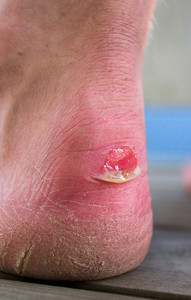 Those who spend a large amount of time putting pressure on their feet are prone to developing blisters, or pockets of fluid between layers of skin which develop due to friction. Minor blisters should not be popped, and instead left alone and covered to provide cushioning and avoid further friction. Prevent the development of blisters by wearing proper-fitting shoes and socks that provide ample comfort and support. Be sure to treat blisters immediately after discovery to avoid pain and disruption of daily activities. If a blister ruptures, immediately disinfect the area and treat it with antibiotic ointment. Consult with a doctor if the pain persists or there is any sign of infection.
Those who spend a large amount of time putting pressure on their feet are prone to developing blisters, or pockets of fluid between layers of skin which develop due to friction. Minor blisters should not be popped, and instead left alone and covered to provide cushioning and avoid further friction. Prevent the development of blisters by wearing proper-fitting shoes and socks that provide ample comfort and support. Be sure to treat blisters immediately after discovery to avoid pain and disruption of daily activities. If a blister ruptures, immediately disinfect the area and treat it with antibiotic ointment. Consult with a doctor if the pain persists or there is any sign of infection.
Blisters are prone to making everyday activities extremely uncomfortable. If your feet are hurting, contact Dr. Dean D. Hinners of Illinois. Our doctor can provide the care you need to keep you pain-free and on your feet.
Foot Blisters
Foot blisters develop as a result of constantly wearing tight or ill-fitting footwear. This happens due to the constant rubbing from the shoe, which can often lead to pain.
What Are Foot Blisters?
A foot blister is a small fluid-filled pocket that forms on the upper-most layer of the skin. Blisters are filled with clear fluid and can lead to blood drainage or pus if the area becomes infected.
How Do Blisters Form?
Blisters on the feet are often the result of constant friction of skin and material, usually by shoe rubbing. Walking in sandals, boots, or shoes that don’t fit properly for long periods of time can result in a blister. Having consistent foot moisture and humidity can easily lead to blister formation.
Prevention & Treatment
It is important to properly care for the affected area in order to prevent infection and ease the pain. Do not lance the blister and use a Band-Aid to provide pain relief. Also, be sure to keep your feet dry and wear proper fitting shoes. If you see blood or pus in a blister, seek assistance from a podiatrist.
If you have any questions, please feel free to contact one of our offices located in Metropolis and Eldorado, IL . We offer the newest diagnostic and treatment technologies for all your foot care needs.
Read more about Blisters on the FeetFoot Health Determines Overall Health
Looking at a person’s feet can help determine how healthy their overall body is. Some important factors to look for include: sudden or chronic pain in the feet, skin discoloration which can indicate a more serious problem, and numbness or peripheral neuropathy which is typically associated with diabetes. Other symptoms of potential health problems are: swelling or edema which can be caused by insufficient veins or lymphatic ducts, cold feet which is most commonly associated with arterial disease, itchy feet which is associated with fungal infections, and changes in your foot structure, such as flatfoot. Overall, any noticeable changes should be looked at by your podiatrist, as our feet are the bedrock of our bodies.
Everyday foot care is very important to prevent infection and other foot ailments. If you need your feet checked, contact Dr. Dean D. Hinners from Illinois. Our doctor can provide the care you need to keep you pain-free and on your feet.
Everyday Foot Care
Often, people take care of their bodies, face and hair more so than they do for their feet. But the feet are a very important aspect of our bodies, and one that we should pay more attention to. Without our feet, we would not be able to perform most daily tasks.
It is best to check your feet regularly to make sure there are no new bruises or cuts that you may not have noticed before. For dry feet, moisturizer can easily be a remedy and can be applied as often as necessary to the affected areas. Wearing shoes that fit well can also help you maintain good foot health, as well as making it easier to walk and do daily activities without the stress or pain of ill-fitting shoes, high heels, or even flip flops. Wearing clean socks with closed shoes is important to ensure that sweat and bacteria do not accumulate within the shoe. Clean socks help to prevent Athlete’s foot, fungi problems, bad odors, and can absorb sweat.
If you have any questions please feel free to contact one of our offices located in Metropolis and Eldorado, IL . We offer the newest diagnostic and treatment technologies for all your foot and ankle needs.
Read more about Every Day Foot CareDiabetic Patients and Cold Weather
Diabetic patients who have poor circulation and nerve damage are most prone to foot problems, especially in cold weather conditions. Moisture from cold weather can collect in your shoes and socks, soaking your feet, leading to the propagation of bacteria and possibly an infection. Diabetic patients should remember to change their socks often when going out in cold weather, and to moisturize their dry feet. Avoid using warming aids on your feet, as this can be dangerous for patients who have numbness due to peripheral neuropathy. Properly-fitting shoes, combined with sufficient soles and moisture-wicking socks, are necessary to ensure proper care for diabetic patients.
Diabetic foot care is important in preventing foot ailments such as ulcers. If you are suffering from diabetes or have any other concerns about your feet, contact Dr. Dean D. Hinners from Illinois. Our doctor can provide the care you need to keep you pain-free and on your feet.
Diabetic Foot Care
Diabetes affects millions of people every year. The condition can damage blood vessels in many parts of the body, especially the feet. Because of this, taking care of your feet is essential if you have diabetes, and having a podiatrist help monitor your foot health is highly recommended.
The Importance of Caring for Your Feet
- Routinely inspect your feet for bruises or sores.
- Wear socks that fit your feet comfortably.
- Wear comfortable shoes that provide adequate support.
Patients with diabetes should have their doctor monitor their blood levels, as blood sugar levels play such a huge role in diabetic care. Monitoring these levels on a regular basis is highly advised.
It is always best to inform your healthcare professional of any concerns you may have regarding your feet, especially for diabetic patients. Early treatment and routine foot examinations are keys to maintaining proper health, especially because severe complications can arise if proper treatment is not applied.
If you have any questions please feel free to contact one of our offices located in Metropolis and Eldorado, IL . We offer the newest diagnostic and treatment technologies for all your foot and ankle needs.
Read more about How to Care for Diabetic FootHow to Avoid Achilles Tendon Injuries
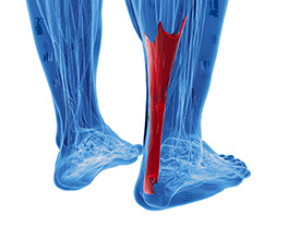 If you find yourself engaging in vigorous activity, but only on the weekends, this is something you should be aware of. Injuries like Achilles tendonitis, or a ruptured Achilles tendon, can happen very quickly. For us non-professional athletes that don’t have time in our busy schedules to reach pinnacles of muscular strength, we are more susceptible to these acute injuries. The Achilles tendon connects the heel bone to the calf muscles and is essential to being able to walk. If the tendon ruptures, surgery will be necessary in order to repair this very painful injury. Achilles tendonitis is when the tendon becomes inflamed, typically due to overuse or not stretching beforehand. Both of these conditions can be treated by a podiatrist and if you experiencing intense heel pain you should consult with one immediately. In order to avoid these injuries, strengthening the tendon by gradually stressing them over time may be helpful. And always remember to stretch!
If you find yourself engaging in vigorous activity, but only on the weekends, this is something you should be aware of. Injuries like Achilles tendonitis, or a ruptured Achilles tendon, can happen very quickly. For us non-professional athletes that don’t have time in our busy schedules to reach pinnacles of muscular strength, we are more susceptible to these acute injuries. The Achilles tendon connects the heel bone to the calf muscles and is essential to being able to walk. If the tendon ruptures, surgery will be necessary in order to repair this very painful injury. Achilles tendonitis is when the tendon becomes inflamed, typically due to overuse or not stretching beforehand. Both of these conditions can be treated by a podiatrist and if you experiencing intense heel pain you should consult with one immediately. In order to avoid these injuries, strengthening the tendon by gradually stressing them over time may be helpful. And always remember to stretch!
Achilles tendon injuries need immediate attention to avoid future complications. If you have any concerns, contact Dr. Dean D. Hinners of Illinois. Our doctor can provide the care you need to keep you pain-free and on your feet.
What Is the Achilles Tendon?
The Achilles tendon is a tendon that connects the lower leg muscles and calf to the heel of the foot. It is the strongest tendon in the human body and is essential for making movement possible. Because this tendon is such an integral part of the body, any injuries to it can create immense difficulties and should immediately be presented to a doctor.
What Are the Symptoms of an Achilles Tendon Injury?
There are various types of injuries that can affect the Achilles tendon. The two most common injuries are Achilles tendinitis and ruptures of the tendon.
Achilles Tendinitis Symptoms
- Inflammation
- Dull to severe pain
- Increased blood flow to the tendon
- Thickening of the tendon
Rupture Symptoms
- Extreme pain and swelling in the foot
- Total immobility
Treatment and Prevention
Achilles tendon injuries are diagnosed by a thorough physical evaluation, which can include an MRI. Treatment involves rest, physical therapy, and in some cases, surgery. However, various preventative measures can be taken to avoid these injuries, such as:
- Thorough stretching of the tendon before and after exercise
- Strengthening exercises like calf raises, squats, leg curls, leg extensions, leg raises, lunges, and leg presses
If you have any questions please feel free to contact one of our offices located in Metropolis and Eldorado, IL . We offer the newest diagnostic tools and technology to treat your foot and ankle needs.
Read more about What are Achilles Tendon Injuries